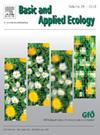New fungal core microbiome members of the ground nesting bee Andrena vaga: The key to oligolecty?
IF 3.5
2区 环境科学与生态学
Q2 ECOLOGY
引用次数: 0
Abstract
To fully understand a species, it is essential to gain knowledge about their associated (micro-)organisms. Currently, most research focuses on managed social bees and their bacterial associates. Functional descriptions of bee-fungi-interactions in solitary bee species, particularly in ground-nesting bees, are lacking. In this study, we identified the yeast community composition associated with the oligolectic mining bee Andrena vaga. We analysed seven different matrices of the early nest stage, using both classical cultivation and ITS2 DNA-metabarcoding. Our results support recent findings that solitary bees can exhibit core microbiomes and give first indications of vertical symbiont transmission for solitary bees, previously only observed in social bees. Particularly, the eggs showed a very distinct yeast composition, with the dimorphic yeast Triodiomyces crassus being the only cultivated species from all egg samples. This smut-related species assimilates salicin and produces antimicrobial glycolipids, potentially used for pollen detoxification and brood cell disinfection. Hence, yeast associates might be a key factor enabling oligolectic bees to specialise on toxic pollen sources. Other identified yeasts, such as Starmerella bombicola, are discussed in terms of their ecology and functionality. Our study provides insights into the crucial role of associated microorganisms and might be the missing link to understand the origin of oligolecty.

新的真菌核心微生物组成员的地面筑巢蜜蜂安德列娜瓦加:寡聚的关键?
要充分了解一个物种,就必须了解与之相关的(微生物)。目前,大多数研究集中在管理的社会蜜蜂和他们的细菌伙伴。在独居的蜜蜂物种中,特别是在地面筑巢的蜜蜂中,缺乏蜜蜂-真菌相互作用的功能描述。在这项研究中,我们确定了与低聚采矿蜂相关的酵母群落组成。我们利用经典培养和ITS2 dna元条形码技术分析了7种不同的巢前期基质。我们的研究结果支持了最近的发现,即独居蜜蜂可以展示核心微生物群,并首次给出了独居蜜蜂垂直共生传播的迹象,以前只在群居蜜蜂中观察到。特别是,鸡蛋显示出非常明显的酵母组成,二态酵母是所有鸡蛋样本中唯一的培养种。这种与黑穗病有关的物种吸收水杨苷并产生抗菌糖脂,可能用于花粉解毒和育巢细胞消毒。因此,酵母菌可能是一个关键因素,使寡聚蜜蜂专门针对有毒花粉来源。其他已确定的酵母,如bombicola Starmerella,在其生态学和功能方面进行了讨论。我们的研究为相关微生物的关键作用提供了见解,并且可能是了解寡聚起源的缺失环节。
本文章由计算机程序翻译,如有差异,请以英文原文为准。
求助全文
约1分钟内获得全文
求助全文
来源期刊

Basic and Applied Ecology
环境科学-生态学
CiteScore
6.90
自引率
5.30%
发文量
103
审稿时长
10.6 weeks
期刊介绍:
Basic and Applied Ecology provides a forum in which significant advances and ideas can be rapidly communicated to a wide audience. Basic and Applied Ecology publishes original contributions, perspectives and reviews from all areas of basic and applied ecology. Ecologists from all countries are invited to publish ecological research of international interest in its pages. There is no bias with regard to taxon or geographical area.
 求助内容:
求助内容: 应助结果提醒方式:
应助结果提醒方式:


